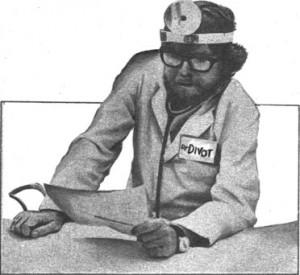March 2014
Dear Doc,
I am concerned with some of the news I have seen lately about the general health of the game of golf. You’re the health guy, Doc. What’s up? Over 650 courses closed in the past five years, fewer players teeing it up. I fell for a girl in High School and that didn’t last too long. Have I now fallen in love with a game whose days are numbered? Will I run out of places to play?
Just Want to Know
Dear JWK,
Don’t panic. While it’s true there have been far more course closings than openings in the past few years, there are still over 15,000 places to play in the United States.
One problem was that there was a course building boom for a while. Between 1990 and 2005 over 3,200 courses opened in the U.S. A lot of them were real estate developments, many were “high-end” resort courses with “member-for-a-day” prices that would have covered the Doc’s first semester in Med School.
Several things worked against the industry: of course there was the Great Depression in the first decade of this century that severely cut the number of golfers and the number of rounds they played; second was a shift in life-style. Parents with families seemed less willing to commit to the “country club” life. Kids’ soccer, little league and other sports took more time. And discretionary income was stressed.
But let’s get real. There’s more than one kind of golfer. Some of us are golf addicts and play every chance we get. We’re the exception, not the rule. We patronize the same course every week, maybe pay an annual membership fee to keep a handicap and to have access to preferred tee times, probably take at least one golf-related vacation or “buddy trip” every year, maybe play in a few state or local tournaments… you know who you are.
Then there are the other guys. They play in a scramble or two, maybe get out when their brother-in-law comes to town, and get talked into nine holes after work a few times a year. But when they do play they usually take a cart, have to buy some balls, get a beverage or two from the cart girl and, generally spend more than the regulars do ’cause it’s a special event for them… and they’re having fun.
The trick for course operators is how to get these people to come back more often. Here’s the Doc’s prescription:
Make it easy. This is a hard game, JWK. To be any good (depending on what your idea of “good” is) takes time and patience. Courses that are too long for the average player, with long forced-carries, too many hazards and impossible hole locations do not encourage duffers and beginners to come back.
Make it fun. Encourage people to play from tees appropriate to their skill level. “Play it Forward” should be the rule of the day. Starters and Marshalls should be schooled in courteous ways to encourage players to move up and have more fun. Encourage the Superintendent to cut the cups in accessible places, especially on weekends. Run games like closest to the hole, “red ball” (where any player who plays the same red ball for all 18 holes gets a free round) or other promotional games. Create a change of pace from the normal round of golf.
Make it fast. I can’t say enough about the way pace of play is killing the game. It drives the Doc crazy to see Marshalls driving around the course and saying nothing to groups that have fallen behind the players in front of them; never helping a group searching for lost balls; not offering to rake a bunker for a group that has fallen behind. Deputize them! Course operators have to give them authority to enforce pace of play guidelines and support them when they do.
Make it family friendly. Golf’s not going to grow by getting more 45 year-olds to take up the game. We have to have kids and families participating. Why not let kids play for free? Or give cut-prices to parents who bring their children out to the course? Put a set of tees in the fairways about 100 – 175 yards from the green so youngsters can have a chance to make “pars” when playing with mom or dad. Why not give free lessons to kids to get them hooked on the game?
Nearly every course hosts outside events every month. That’s a real revenue maker for the club. Many of the people who play in these charity scrambles and tournaments might have never played the course before and may not come back again until the next charity event. What a missed opportunity. If I was in charge, I’d give every player a discount coupon to encourage them to come back. Maybe they would, maybe not. Private clubs could offer a return round for a discounted price on Monday afternoon when much of the maintenance is complete. If it’s even one more round that wouldn’t have been played otherwise, it would be well worth the effort.
The over-all health of the game, in this Doc’s opinion is okay, JWK, but it could be better.
All of us need to think about growing the game in different ways. Ask your neighbor to join you for a round, take your kids to the course, see if your boss is busy next weekend. If you want to see the game thrive, take just a little bit of responsibility for it.
As they say, “if you keep doing what you’ve been doing, you’ll keep getting what you’ve been getting”.
Dr. C.B. Divot
January 2014
Dear Dr. Divot,
I have subscriptions to all of the major golf magazines. Every month I read some great tips that make eminent sense when I’m sitting at home in my recliner– but when I experiment on the range, or try to take these swing keys to the course, they work for a little while and then I’m right back to where I started.
I really want to get better. I like winning skins and collecting wagers, but I’m getting frustrated…nothing seems to work for very long. Any suggestions?
Tinkerer
Dear Tink,
The ol’ Doc tried to get through Med School by just reading the textbooks, but it soon became clear that the only way to graduate was to go to class, do the labs, and ask questions.
Reading about the golf swing to try to understand the bio-mechanics and cause/effect of what you are doing is pretty much a waste of time. I don’t discount the entertainment value of all those magazines you read, but it takes more to really learn and understand the golf swing.
My old friend and colleague, Dr. Rueben Rock, has done extensive research on this. He tells me that swing keys and quick fixes for the golf swing have a carbon half-life of about three holes. Like you say, they work for a while…then they don’t. So you spin the mental “rolodex” to try to find the next band-aid to get you through the round.
Another of Dr. Rock’s studies has verified something I have suspected for a long time. Tink, the average golfer will gladly spend $300 or $400 on the newest driver, but won’t part with fifty bucks for a lesson! One might get you five more yards, the other will get you five more fairways and five more greens.
On the range I see people who are new to the game, some high school players and a few mid- to high- handicappers taking the occasional lesson. What I don’t see are the more experienced players – the ones who have played for five or more years – on the range working with their local PGA Professional.
There are wonderful new “toys” that pros are using today to help analyze the golf swing. Launch monitors, video analysis… it’s all good.
Just being able to see your own swing on video will be a great help in understanding why you slice your tee ball, how “coming over the top” affects ball flight, why your grip is the root of many of your problems, or how greater flexibility will improve your move to the ball. Add the watchful eye and expertise of your local pro and you can be on your way to making changes that will last for more than a few holes.
If, like the ol’ Doc, you have ever struggled with trying to lose ten or fifteen pounds, you probably know that dieting alone doesn’t work. You’ve got to make life-style changes to get lasting results.
It’s the same with your golf swing, Tink. Quick fixes, band-aids and “the cure du jour” aren’t going to make you a better player. You need to make meaningful, sequential alterations that will last. And I believe the only way to do that is under the trained eye of a PGA Professional.
You want to get into your buddies’ wallets? The Doc’s prescription is to take a lesson, work on the range to ingrain the changes, take them to the course. In a few weeks, take another lesson and repeat as necessary.
If Tiger Woods needs a swing coach, if every player on the PGA TOUR has someone to help keep their swings in tune, don’t you think it’s time to quit tinkering and get with the program?
Dr. C.B. Divot
Send questions or comments to [email protected]
© Copyright 2014 dhk. All rights reserved


